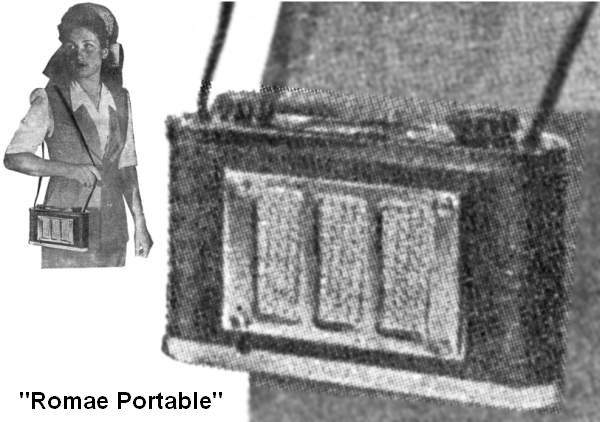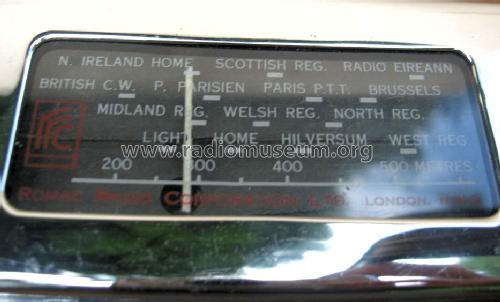Personal 106
Romac Radio Corporation, Ltd.; London
- Country
- Great Britain (UK)
- Manufacturer / Brand
- Romac Radio Corporation, Ltd.; London
- Year
- 1946
- Category
- Broadcast Receiver - or past WW2 Tuner
- Radiomuseum.org ID
- 18909
-
- alternative name: Romac USA
Click on the schematic thumbnail to request the schematic as a free document.
- Number of Tubes
- 4
- Main principle
- Superheterodyne (common); ZF/IF 465 kHz; 1 AF stage(s)
- Tuned circuits
- 4 AM circuit(s)
- Wave bands
- Broadcast only (MW).
- Power type and voltage
- Dry Batteries
- Loudspeaker
- Permanent Magnet Dynamic (PDyn) Loudspeaker (moving coil)
- Material
- Various materials
- from Radiomuseum.org
- Model: Personal 106 - Romac Radio Corporation, Ltd.;
- Shape
- Portable set > 8 inch (also usable without mains)
- Dimensions (WHD)
- 240 x 120 x 50 mm / 9.4 x 4.7 x 2 inch
- Notes
-
No external aerial and earth socket (that is the 126).
The control knobs are fixed by means of two recessed grub-screws each. All later models (126 and up) use spring fitting.See also the Austrian HEA models Gypsy Gipsy 50 & Gypsy 52
The Portable Romac 106 is the first British receiver using 7pin miniature valves (B7G) used in 1940 in USA (see initial models). Same case for 106(1946), 126(1947), 136L(1948 - with MW and LW), 136S(1948 MW and SW), 236L(1949 with LW and MW) and 236S(1949).
- External source of data
- E. Erb 3-907007-36-0
- Circuit diagram reference
- Die «Thali Schemasammlung» führt das Modell.
- Mentioned in
- Radios von gestern, 2. Auflage
- Literature/Schematics (1)
- Radio! Radio!
- Literature/Schematics (2)
- Trader Service Sheet (suppl. of Wireless & El. Trader, etc.) (940 February 1950)
- Literature/Schematics (3)
- ERT October 1947
- Literature/Schematics (4)
- Radio-Amateur Wien (RA, 46), (Österreichischer Radio Amateur, ÖRA) (7/8 1946, S.408)
- Other Models
-
Here you find 9 models, 8 with images and 8 with schematics for wireless sets etc. In French: TSF for Télégraphie sans fil.
All listed radios etc. from Romac Radio Corporation, Ltd.; London
Forum contributions about this model: Romac Radio: Personal 106
Threads: 4 | Posts: 8
In the November/December 1946 issue of the Austrian radio magazine "Radiotechnik" was a report about the Swiss Autumn exhibition in Zurich (August 28th - September 3rd, 1946).
Amongst other models, was a picture of portable radio named "Romae Portable":

The only data mentioned:
Miniature radio "Romae Portable", appearance like a camera, 4-tube superhet, broadcast band (MW), antenna in the shoulder strip, dimension ~240x135x51mm, weight ~2,2kg (4,85 lb) including batteries.
Unfortunately I did not found any othe reference. Does anybody know more about?
Thank you very much in advance!
Best Regards,
GR
Georg Richter, 11.Aug.13
This information is about a model, as the one already available, but having two bands MW and SW. It is shown in two pictures Personal 106a for the dial showing the two bands lines and the brand identification in the middle of it, when previously was in the lower part. Picture 106b showns the button for changing the band.
I request help for uploading this kind of information in an alternative way of text for the Forum if any.
Excuss my English and any spelling mistake
Attachments
- Dial (34 KB)
- Band ghange (39 KB)
Francisco Gallego, 01.Oct.08
Dispongo de información sobre un modelo posterior al que ya existe. Adjunto dos fotografias que la ilustran. El cambio es que el nuevo aparato es de dos bandas MW y SW.
En la foto Personal 106a se ve el dial con las dos bandas y el nombre del fabricante en la mitad del dial y no en la parte inferior como en el antiguo modelo. En la foto Personal 106b se ve el botón de cambio de banda.
Agradecería información de como proponer este cambio si es que hay otra forma además de ponerla en el Foro.
Attachments
- Dial del aparato con dos bandas (34 KB)
- Botón de cambio de banda (39 KB)
Francisco Gallego, 01.Oct.08
Bill Morris, 01.Nov.02







